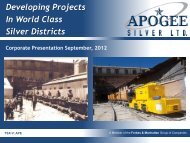Pulacayo Project Feasibility Study - Apogee Silver
Pulacayo Project Feasibility Study - Apogee Silver
Pulacayo Project Feasibility Study - Apogee Silver
Create successful ePaper yourself
Turn your PDF publications into a flip-book with our unique Google optimized e-Paper software.
<strong>Pulacayo</strong> 1 000 t/d Phase I <strong>Feasibility</strong> <strong>Study</strong> - NI 43-101 Technical Report<br />
090644-3-0000-20-IFI-100<br />
The corresponding budget for these works have been already disbursed by the Client and are<br />
therefore Sunk Costs for the present project and will not be considered in the calculation of the<br />
capital cost in the feasibility study.<br />
The earth movement cost and platform construction that has not been built has been estimated<br />
from drawings and quantities derived from the drawings.<br />
Concrete Works<br />
Concrete and formwork quantities were determined based on the mechanical arrangements –<br />
plan/elevation view drawings and sketches. No allowances for over-pour, wastage or rework were<br />
considered. The unitary concrete prices are all-in (concrete reinforcing steel and formwork).<br />
Additionally, the data of the Soil Mechanics <strong>Study</strong> (Geotecnia, Tarifa Fernandez S.R.L., Bolivia,<br />
Julio 2011) was taken into consideration to calculate the bearing capacity and depth of the<br />
concrete foundations.<br />
To size the foundations for vibrating equipment, a ratio in the range of 1 to 3 (for each ton of<br />
equipment, three tons of concrete is used) was used.<br />
For foundations for structures, the concrete dimensioning is subject to a weight ratio of the<br />
structure (kg) per foundation area (m 2 ) given that this relationship should not be below the soil<br />
bearing capacity.<br />
Reinforcing steel is obtained by ratios (kg/m 3 ) according to the volume of concrete and structural<br />
elements (footings, slabs, columns, walls, beams). The unit of measure of the cost of concrete is<br />
based on ratios in USD/m 3 . These ratios are in according to the TWP database of similar<br />
projects.<br />
The concrete price included supply of concrete from an on-site batch plant.<br />
For slabs, the quantity of concrete to be used depends on the application. For pedestrian traffic,<br />
concrete is 15 cm thick, for light traffic, concrete is 20 cm thick. If the slab is to be used for heavy<br />
machinery traffic, the concrete thickness is in the range of 25 cm to 30 cm.<br />
d) Structural Steel Works<br />
Structural steel quantities were developed from general arrangement drawings and experience<br />
from previous projects of similar nature. Unit rates (USD/kg) have been provided by regional<br />
contractors. The weights include allowances for connections, stiffeners, clips, base plates, etc.<br />
e) Equipment (Process and Mechanical)<br />
The equipment was classified and budgeted from the Equipment List. The providers quotations<br />
are a fundamental part in the selection of the equipment considered in this study (main and<br />
secondary equipment). As is necessary, most of the equipment and material will be imported due<br />
to a lack of availability in Bolivia. Where equipment is available in Bolivia, it will be procured<br />
locally. Imported equipment will be shipped by ocean, rail and trucks. Transport costs have been<br />
considered as indirect costs and have been estimated from quotations from logistics companies<br />
operating in South America. Equipment already purchased by <strong>Apogee</strong> was excluded (Maelgwyn<br />
flotation cells, Andritz press filters, and Pengfei comminution equipment).<br />
TWP Sudamérica S.A. Av. Encalada 1257 Of. 801, Santiago de Surco Lima 33, Perú (51-1) 4377473<br />
Page 262



